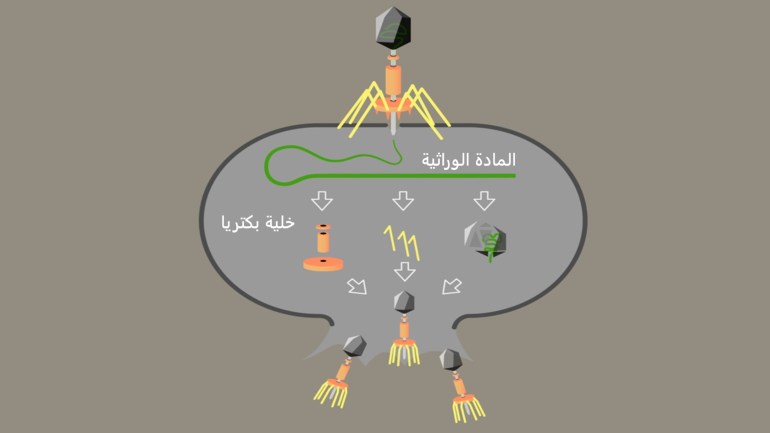Were you ever imagining that you would have spears to hit your enemy without harming your friends if you fell on them?
Of course, such an order would be an important preemptive advantage in war.
However, there are many nature wars, and one of them amazes her recently with having one of these pointed spears.
Viruses are bacteria-eating
There are known types of viruses that attack bacteria called bacteriophages.
Phages consist of a hexagonal protein head that captures their genetic material, and a simple tail that helps them cling to and attack the host.
The human gut contains billions of these phages that help get rid of harmful bacteria.
Scientists are trying to use the advantage of phages and their simple structure to transfer specific genetic material with a desired function into cells.
It can also be used as an effective alternative to antibiotics.
However, there are new bacterium-produced weapons known as tailocins, which are highly effective nanoparticle machines.
Tylosin is similar to phages, except that it does not have that head containing the genetic material, and thus it lacks the instruction manual needed to duplicate its genetic material and to reproduce it.
Tylosins cling to the target cell and then penetrate the cell membrane (Wikipedia - Vectoramius)
Nanoparticles
Tylosins act as pricking needles, as they cling to the target cell, and then penetrate the cell membrane and reach the cytoplasm, causing an imbalance in the cell's content and ions, which leads to cell breakdown.
Tylosins are produced by a variety of bacteria - capable of producing these tail remnants - that are under conditions of stress.
Tylosins are considered guided weapons, as they kill only certain strains, making them known as "bacterial guided missiles."
Tylocinate appears to be the bacterium's weapon against its competitors.
Given their similarity to phages, scientists believe that "tylocins" are the product of the genetic material that the phages have introduced into bacteria.
Over time, the bacteria got rid of the parts of that DNA they entered that were not useful to them, while preserving the part that might give them a new advantage.
Tylosins come out from the membranes of bacteria as phages do (Al-Jazeera)
Double weapon
Once released from the bacteria, these weapons target specific strains of the host's cells and not others.
But these guns work oddly.
It also kills the bacteria that produce it, as if the bacteria had already been attacked by the phages.
These tapered nanomachines come out of the membranes of bacteria as phages do, too, causing damage to the bacteria.
Keeping the bacteria on such a self-harming weapon thus contradicts the voluntary capabilities of evolution.
But this weapon protects his family from harm, as it targets certain breeds when it comes out.
Thus this behavior only harms the bacterial individual who is producing it, at a time when it protects its relatives from harm.
Scientists do not know the mechanism by which these nanoscale needles work.
In a recent study published in The ISME on March 1, scientists at Lawrence Berkeley National Laboratory in the United States studied the genetic and physical mechanism by which these nanoscale needles target strains. Certain but not others.
According to the press release published by the laboratory in response to the study, the scientists examined 12 strains of soil bacteria that produce "tellosin".
Some of the components that bind to the outer membranes of the cell determine the ability to target the cell with "telosin" (communication sites).
Targeting mechanism
Adam Arkin, the study’s lead researcher, commented on this mechanism, saying, “We are fond of knowing how to keep a certain type of bacteria alive, especially under challenging and resource-free conditions like the soil bacteria we studied.”
Scientists have found that some of the lipopolysaccharides (lipopolysaccharides) that are linked to the outer membranes of the target cell determine the ability to target the cell with "Tylosin" or not.
Thus, understanding this targeting mechanism helps scientists engineer bacteria that are able to produce "tellosin" in the laboratory.
Given that we do not know the role played by the majority of microbes in the environment, we may soon be able to conduct more experiments on the roles of these organisms, using correctly engineered "tellosins".
Tylocins can also be used as an alternative to traditional antibiotics, which randomly eliminate both beneficial and harmful strains, not to mention the increasing resistance of many bacteria to many antibiotics.

